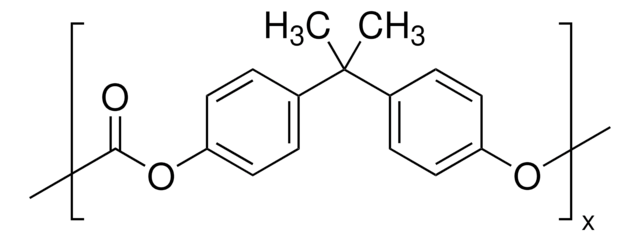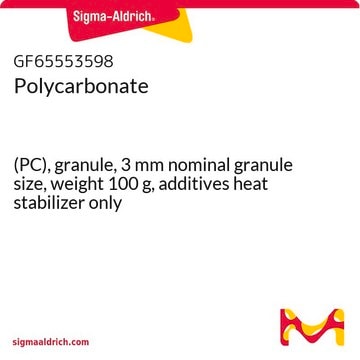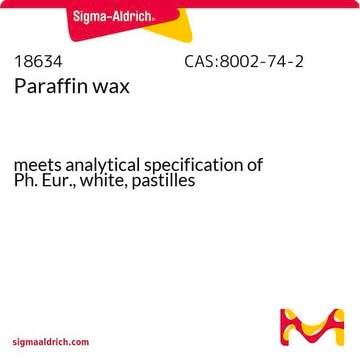If this product has an expiration or retest date, it will be shown on the Certificate of Analysis (COA, CofA). If there is no retest or expiration date listed on the product's COA, we do not have suitable stability data to determine a shelf life. For these products, the only date on the COA will be the release date; a retest, expiration, or use-by-date will not be displayed.
For all products, we recommend handling per defined conditions as printed in our product literature and website product descriptions. We recommend that products should be routinely inspected by customers to ensure they perform as expected.
For products without retest or expiration dates, our standard warranty of 1 year from the date of shipment is applicable.
For more information, please refer to the Product Dating Information document: https://www.sigmaaldrich.com/deepweb/assets/sigmaaldrich/marketing/global/documents/449/386/product-dating-information-mk.pdf
Kluczowe dokumenty
181625
Poly(Bisphenol A carbonate)
average Mw ~45,000 by GPC
Synonim(y):
Homopolimer węglanu bisfenolu A, Kopolimer kwasu węglowego-4,4′-dihydroksydifenylo-2,2-propanu, Poli(węglan dianu), Poli[węglan 2,2-bis(4-hydroksyfenylo)propanu], Polimer węglanu 4,4′-dihydroksydifenylo-2,2-propanu
Wybierz wielkość
810,00 zł
Wybierz wielkość
About This Item
810,00 zł
Polecane produkty
masa cząsteczkowa
average Mw ~45,000 by GPC
Poziom jakości
współczynnik refrakcji
n20/D 1.585
temp. przejścia
Tg 150 °C
Tm 267 °C
gęstość
1.2 g/mL at 25 °C (lit.)
ciąg SMILES
CC(C)(c1ccc(O)cc1)c2ccc(O)cc2
InChI
1S/C15H16O2.CH2O3/c1-15(2,11-3-7-13(16)8-4-11)12-5-9-14(17)10-6-12;2-1(3)4/h3-10,16-17H,1-2H3;(H2,2,3,4)
Klucz InChI
XSXWYGABGYBZRM-UHFFFAOYSA-N
informacje o genach
mouse ... Esr1(13982)
rat ... Ar(24208)
Szukasz podobnych produktów? Odwiedź Przewodnik dotyczący porównywania produktów
Powiązane kategorie
Opis ogólny
Zastosowanie
- To prepare transparent nanocomposites for optical applications.
- To study the wettability of graphene.
Kod klasy składowania
11 - Combustible Solids
Klasa zagrożenia wodnego (WGK)
WGK 3
Temperatura zapłonu (°F)
Not applicable
Temperatura zapłonu (°C)
Not applicable
Środki ochrony indywidualnej
Eyeshields, Gloves, type N95 (US)
Wybierz jedną z najnowszych wersji:
Masz już ten produkt?
Dokumenty związane z niedawno zakupionymi produktami zostały zamieszczone w Bibliotece dokumentów.
Klienci oglądali również te produkty
-
How can I determine the shelf life / expiration / retest date of this product?
1 answer-
Helpful?
-
-
How is shipping temperature determined? And how is it related to the product storage temperature?
1 answer-
Products may be shipped at a different temperature than the recommended long-term storage temperature. If the product quality is sensitive to short-term exposure to conditions other than the recommended long-term storage, it will be shipped on wet or dry-ice. If the product quality is NOT affected by short-term exposure to conditions other than the recommended long-term storage, it will be shipped at ambient temperature. As shipping routes are configured for minimum transit times, shipping at ambient temperature helps control shipping costs for our customers. For more information, please refer to the Storage and Transport Conditions document: https://www.sigmaaldrich.com/deepweb/assets/sigmaaldrich/marketing/global/documents/316/622/storage-transport-conditions-mk.pdf
Helpful?
-
-
What is the form of product 81625, Poly(Bisphenol A carbonate)? Is it a liquid or a solid? If it is a solid, how so I solubilize it?
1 answer-
The product is in the form of pellet/solid. It is soluble in dichloromethane and p-dioxane, and slightly soluble in aromatic hydrocarbons and ketones.
Helpful?
-
Active Filters
Nasz zespół naukowców ma doświadczenie we wszystkich obszarach badań, w tym w naukach przyrodniczych, materiałoznawstwie, syntezie chemicznej, chromatografii, analityce i wielu innych dziedzinach.
Skontaktuj się z zespołem ds. pomocy technicznej










